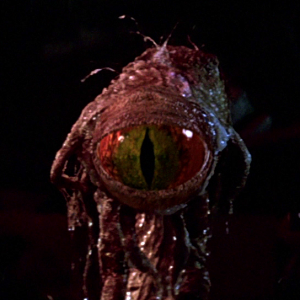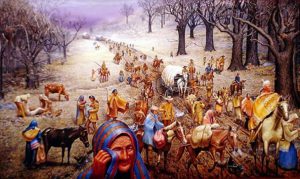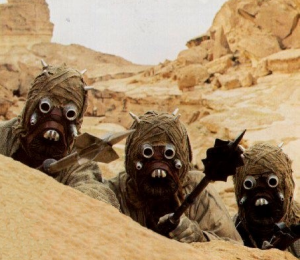Landlessness throughout Star Wars
Star Wars displays the postcolonial concept of landlessness through the Empire’s sheer power and conquest that results in driving people out of their homes and depriving them of their land. This relates to the real world situation involving the U.S. government and Native Americans. The U.S. government took away Native American lands to benefit their own citizens, disregarding the Native American culture and sacred land. On the other hand, there are groups of beings throughout Star Wars that choose to be nomadic throughout the films. This is similar to early man when they were nomads and roamed the earth. Overall, the main cause of landlessness in Star Wars is the Empire’s conquest and exploitation of planets for their own benefit.
(8) Video: Shows Empire taking over Wookie home planet of Kashyyyk
The Empire is a dominant force that takes what it wants whenever it wants it. It rules through fear and threatens people’s lives if they challenge them. One of the first instances where the Empire demonstrates its power and takes land from a species is seen in its creation. The Empire is born through the vision of Chancellor Palpatine, who is secretly a Sith Lord and wants to restore the Sith to power in the Galaxy. At the end of the Clone Wars, Palpatine executes order 66 in which the clones, who were supposed allies of the republic and Jedi, betray the Jedi and republic for Palpatine and his Empire. In Revenge of the Sith, the clone betrayal is demonstrated on Chewbacca’s home planet of Kashyyyk. The clones begin to fire on the Wookies and take their planet hostage. They enslave all the wookies who were not killed. This unnecessary killing and exploitation of the Wookie homeland displayed the Galactic Empire’s power to the whole galaxy. The Empire established itself as a dominant force in the galaxy through this violation of Kashyyyk and terrified anyone who thought of standing up to them.

(5)Pictured: Omi, also known as “The Baptist”, was taken from her home by the Empire and forced to live in a trash dump on the Death Star.
Another example of the empire taking lands and leaving beings without homes is shown in the short story titled “The Baptist”, in Star Wars from a Certain Point of View. This story is told through the point of view of the dianoga Omi. Omi is taken from her homeland by the Empire to break down trash in a container on the Death Star. Omi thinks to herself after her capture, “Omi could see the swamplands right out her window, just beyond a flat, hard-looking plane of land. She’d seen these metal beasts before, passing through the sky, far above the trees, so large that one could be inside them and live. They flew here and there. She’d never imagined she’d be swallowed by one, contained in a crystal bowl. She pressed herself against her transparent prison, trying to get close to home as possible”(319). Omi was living her life until the Empire came and captured her because they wanted her to break down garbage in the Death Star. Her desire to go home is evident but she understands she will probably never return again. The Empire does not see Omi as a creature, but as an object to help them and their plans. They do not care for her feelings, home, or life. This exploitation and forced removal of Omi and the Wookies on Kashyyyk directly relates to the real world situation between the U.S. government and the Native Americans.

(3)Pictured: Trail of Tears
When North America was colonized by European countries the native peoples’ lives were greatly impacted. On May 28, 1830 president Andrew Jackson signed the Indian Removal Act (Library of Congress Information Bulletin). This authorized the president to grant unsettled lands west of the Mississippi in exchange for Indian lands within existing state borders. This began the “Trail of Tears” which resulted in the forced removal of 16,000 Cherokees. 4,000 Cherokees ended up dying on the journey to the west. Currently, government designed reservations set aside for Native Americans contain many social problems such as overcrowding, drugs, poverty, and alcoholism (Library of Congress Information Bulletin). The U.S. government has tried to intervene on the reservations but struggles in finding ways because they consider it a trivial issue. In the past, the main project to help the Native Americans was when the U.S. government tried to assimilate Native Americans into western culture. The government made them change their names, clothes, and appearances. The government had a complete disregard of Native American culture and still does present day. In this real world atrocity, the treatment in the past and present by U.S. government to the Native Americans is similar to that of the Empire in the galaxy. Similarly, the Empire exploited Kashyyyk for its people and resources. They also did this in the case of Omi when they took her from her home to eat trash in a metal cage for the rest of her life. The actions of the Empire and the U.S. government display the postcolonial trend that imperialist powers take land from the indigenous peoples so they can have it for themselves. They have no regard for the indigenous peoples and do not care how their lives are impacted by imperialism.

(1)Pictured: The effects of assimilation on a Native American family

(10)Pictured: Death Star causes internal landlessness for its own workers.
The Empire does not only create landlessness and remove homes externally, but also creates a sense of internal landlessness for its workers. This is seen when the Empire binds workers to the Death Star and makes them work abroad. The workers only focus on their single job and are deemed too insignificant by the Empire to know about anything that goes on inside or outside the Death Star. In the short story titled “End of Watch” from Star Wars from a Certain Point of View, Commander Poul reflects on working on the Death Star thinking, “But that was the thing about the Death Star. The battle station was so big that, short of a Star Destroyer crashing into it, most of the crew would have no idea about what was going on at any given time. Only essential mission personnel had the required clearance. Poul understood that. It was a matter not just of security, but also of pure logistics”(311). Poul explains how the sheer size of the Death Star creates this unique working environment where the workers do what they are told and are blocked by the Empire from everything else going on. The Empire does not care about the individual worker. Workers to do their job so they can proceed with their bigger plans. This dynamic working environment where the workers sleep at their place of work creates no divide between work and their home. The size, secrecy, and logistics of the Death Star creates landlessness for the Empire’s own workers and leaves them with no real home.

(4)Pictured: Tusken Raiders
Although the Empire does force landlessness on some beings, others in the Star Wars universe choose a nomadic lifestyle. In A New Hope, the audience is introduced to two different nomadic species in the Jawas and the Tusken Raiders. The Jawas are portrayed as little creatures who wear dark hoods that only show their beady eyes. They make a living by selling droids and spare parts off of their barge. The Tusken Raiders are depicted as aggressive creatures that wear menacing masks. They are even given the nickname “sand people” in the movie. They raid in groups and pillage unreservedly. Both of these nomadic groups are shown as and given features that characterize them as inhumane. They are distant from the main society and are portrayed as minor groups in the movies. The humans in Star Wars identify a stigma against them when they discuss the “sand people” in a brutish, negative light. In the real world, this is seen in the treatment of immigrant domestic workers. There is a strong stigma against domestic workers in that they do not do real work. People do not qualify taking care of other people’s kids as work. Society ignores them because of the stigma that they are illegal, poor, and have no education. This is similar to the stigma associated to the Tusken Raiders. They are considered animal-like and the way they make their living is frowned upon in the Star Wars society. They are considered inferior in every way and the audience deduces this from the way these nomadic beings look and are treated by the main characters.

(2)Pictured: Jawas
This idea of inferiority relates to human perceptions of early man when he was a nomad. The mainstream point of view on early nomads is that they were intellectually and socially inferior to what humanity is presently. Many humans are no longer nomads and having a stable home in a set place shows power, wealth, and stability. This relation to early humans would cause the audience to believe that the nomadic Jawas and Tusken Raiders are inferior to the main characters and groups in Star Wars. This nomadic lifestyle and chosen landlessness by these two groups helps contribute to the postcolonial concept of subaltern knowledge. Postcolonialism: A Very Short Introduction, written by Robert J. C. Young, defines subaltern knowledge as “a general name for the insurgent knowledges that come from the subaltern and the dispossessed, and that seek to change the terms and values under which we all live”(18). The audience relates these inhumane groups to nomads which make them seem inferior and less important than the main characters in the story. Regardless, of whether George Lucas intended to display the Jawas or Tusken raiders in this inferior light, their nomadic tendencies and inclination to landlessness contribute to the theme of subaltern knowledge. Consequently, the audience compares them to early man and assumes these two groups in Star Wars are socially, politically, and intellectually inferior to the rest of the Galaxy.
The Star Wars films A New Hope and Revenge of the Sith, as well as the book Star Wars From a Certain Point of View, show how the Empire exploits planets to seize their people and resources, which results in the planet’s inhabitants’ landlessness. This is similar to the real life example of what the U.S. government did to the Native Americans. In both cases, the imperial powers took what they wanted and had no care for the indigenous peoples they exploited. The Empire’s prized weapon, the Death Star, also creates landlessness for its own workers because its vast size creates no separation of work and home. There is also the ever present aspect of secrecy throughout the Death Star which creates information asymmetry and an exploitative labor climate. Although the Empire forces landlessness internally and externally, the nomadic Jawas and Tusken Raiders show the side of chosen landlessness throughout Star Wars. The inhumane appearance and actions of these aliens helps contribute to the comparisons between them and early humans. This comparison displays these characters to show how they have subaltern knowledge and are inferior in the Star Wars society. People can relate the real world to Star Wars by analyzing the postcolonial aspect of landlessness throughout the Star Wars universe. Relating this multimedia empire to the real world allows people to connect what they watch to their real lives, as well as history. Star Wars shows the historical similarities between the Empire and the U.S. government. These similarities show that the U.S. can be menacing and ruthless, exactly as the Empire is portrayed and viewed. This exposes the reality that the U.S. is a devastating imperial power and constantly creates landlessness throughout their conquest.
Works Cited
- “Gwich’in Steering Committee.” Gwichin Steering Committee, www.gwichinsteeringcommittee.org/the-forced-assimilation-of-native-americans.html.
- “Jawa.” Wookieepedia, starwars.wikia.com/wiki/Jawa.
- Lucas, George, et al. Star Wars, Episode III, Revenge of the Sith. 20th Century Fox, 2005.
- Miller, Mark. “The Tragedies That Befell the Five Civilized Tribes That Were Forced to Trek the Trail of Tears.” Ancient Origins, Ancient Origins, 19 Sept. 2018, www.ancient-origins.net/history-important-events/trail-tears-0010725.
- “Moab – Part 7.” How’s It Going, Eh?, 29 Jan. 2014, howsitgoing-eh.com/2012/06/21/moab-part-7/.
- “Omi.” Wookieepedia, starwars.wikia.com/wiki/Omi.
- Planning D-Day (April 2003) – Library of Congress Information Bulletin, Victor, www.loc.gov/teachers/classroommaterials/presentationsandactivities/presentations/immigration/native_american2.html.
- “Star Wars The Battle of Kashyyyk HD.” YouTube, YouTube, 5 Feb. 2017, youtu.be/jeK_wORqu7g?t=162.
- “Star Wars IV: a New Hope.” Lucas Film Ltd, 2008.
- Star Wars: from a Certain Point of View. Century, 2017.’
- “The Playlist: A Guide to the First Death Star’s Biggest Moments.” StarWars.com, 18 Oct. 2016, www.starwars.com/news/the-playlist-the-first-death-star.
- Young, Robert J. C. Postcolonialism: A Very Short Introduction. Oxford University Press, 2003.

Garrett Lusk in his paper “Landlessness throughout Star Wars ” speaks upon the issue of landlessness. Through his analysis of the violent actions of The Galactic Empire to achieve more control of the universe he explains the effects of their actions on other alien species in the universe. He draws upon the historical event in which Americans forced Native Americans off of their land to establish the cruelty of an Imperial power. He makes evidently clear that the use of force by the Imperial powers for their own agenda leads to landlessness.
While Lusk makes a notable point about the negative effects, the Empire has on another species in the universe. The Empire is not evil in its entirety. There are many attempts within the Empire to correct its wrongs. For example, a History Today article talks about an individual by the name of John Collier, Commissioner for Indian Affairs, who proposed the 1934 Indian Reorganisation Act (IRA). The intention with this policy was to preserve the land and communities of the Native Americans as the article claims “the policy of allotment, banned the further sale of Indian land and decreed that any unallotted land not yet sold should be returned to tribal control. It also granted Indian communities a measure of governmental and judicial autonomy” (Boxer). Through the description of the policy, it was evident that some members who held powerful positions in government tried to help correct the wrongs of the Imperial power as a whole. Lusk proclaims, “They [The Galactic Empire and the U.S.A] have no regard for the indigenous peoples and do not care how their lives are impacted by imperialism” (Lusk). This is only partially true as some people like Collier have attempted to correct the wrongs of the nation as a whole.
Laurence Barr-Forget in his essay “Children of the Universe” talks about the meaning of family and how most characters in Star Wars Universe end up adopting a family. He writes, “ In their new family, each plays a role in supporting and nurturing the others. It is only through teamwork that they can achieve their goals. Each started out as an individual alone in the universe. Chewbacca escaping the slavery of the Empire (Solo) and Han struggling to make it on his own (Solo) were the first united in Solo where they began their relationship as partners” (Barr-Forget). As the series continues it becomes more than evident that Han and Chewie are not just partners, they are family. While the Empire has taken homes away from many different species in the Star Wars Universe, they have also provided a home for many others. Through Solo: A Star Wars Story we see that Han is all by himself without a home after he tries to escape the planet of Corellia (Kasden, Solo: A Star Wars Movie). Han approaches a recruiter for the Imperial army who gives Han his last name. Han then meets Chewie through his time with the Imperial army. Chewie becomes part of Han’s family, and together they find their home on the Millennium Falcon. Now the Empire does directly play a role in giving Han a home, but without them, Han would not have been able to get off of Corellia. If he hadn’t made it off of Corellia, he would also have not met Chewie and found his home.
Lusk does make valid points about the actions of the Imperial Empire leading to the landlessness of aliens such as Omi. However, some people within the Empire seek to right the wrongs of the Empire. Through, the landlessness of the Native Americans we see that people like John Collier tried to preserve the land of the Native Americans. Although his plan ended up failing there was still an effort by a member of the Imperial power to resolve an issue they created. In addition, as a result of The Empire’s actions, some people end up finding their families and homes. The Empire might have motives that lead to acts of evil, but there are still a few people who work to make the lives of individuals better.
Works Cited
Barr-Forget, Laurence. “Children of the Universe.” Postcolonial Star Wars, Vassar WordPress, 12
December 2018, http://pages.vassar.edu/postcolonialstarwars/fall-2018/laurence-barr-forget/.
Boxer , Andrew. “Native Americans and the Federal Government.” History Today,
http://www.historytoday.com/andrew-boxer/native-americans-and-federal-government.
Howard, Ron, director. Solo: A Star Wars Story
Lusk, Garrett. “Landlessness throughout Star Wars.” Postcolonial Star Wars, Vassar WordPress,
12 December 2018, http://pages.vassar.edu/postcolonialstarwars/fall-2018/garrett-lusk/.